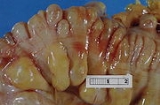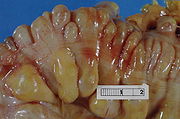
Diverticulum
Encyclopedia
A diverticulum is medical
or biological
term for an outpouching of a hollow (or a fluid-filled) structure in the body. Depending upon which layers of the structure are involved, they are described as being either true or false.
In medicine, the term usually implies the structure is not normally present, i.e., pathological. However, in the embryonic
stage, some normal structures begin development as a diverticulum arising from another structure.
An alphabetical listing of some frequently encountered diverticula follows:
True diverticula involve all layers of the structure, including muscularis propria and adventitia
.
False diverticula do not involve muscular layers or adventitia
. False diverticula, in the GI tract for instance, involve only the submucosa
and mucosa.
Most of these pathological types of diverticulum are capable of harboring an enterolith
. If the enterolith stays in place, it may cause no problems, but a large enterlith expelled from a diverticulum into the lumen
can cause obstruction (see Enterolith
).
Medicine
Medicine is the science and art of healing. It encompasses a variety of health care practices evolved to maintain and restore health by the prevention and treatment of illness....
or biological
Biology
Biology is a natural science concerned with the study of life and living organisms, including their structure, function, growth, origin, evolution, distribution, and taxonomy. Biology is a vast subject containing many subdivisions, topics, and disciplines...
term for an outpouching of a hollow (or a fluid-filled) structure in the body. Depending upon which layers of the structure are involved, they are described as being either true or false.
In medicine, the term usually implies the structure is not normally present, i.e., pathological. However, in the embryonic
Embryo
An embryo is a multicellular diploid eukaryote in its earliest stage of development, from the time of first cell division until birth, hatching, or germination...
stage, some normal structures begin development as a diverticulum arising from another structure.
An alphabetical listing of some frequently encountered diverticula follows:
Anatomical
- Guttural pouch: A large (300-500 ml), paired, air-filled ventral diverticulum of the auditory tube found in horses and other Perissodactyla.
Classification
Diverticula are described as being true or false depending upon the layers involved.True diverticula involve all layers of the structure, including muscularis propria and adventitia
Adventitia
Adventitia is the outermost connective tissue covering of any organ, vessel, or other structure. It is also called the tunica adventitia or the tunica externa....
.
False diverticula do not involve muscular layers or adventitia
Adventitia
Adventitia is the outermost connective tissue covering of any organ, vessel, or other structure. It is also called the tunica adventitia or the tunica externa....
. False diverticula, in the GI tract for instance, involve only the submucosa
Submucosa
In the gastrointestinal tract, the submucosa is the layer of dense irregular connective tissue or loose connective tissue that supports the mucosa, as well as joins the mucosa to the bulk of underlying smooth muscle .-Contents:Blood vessels, lymphatic vessels, and nerves will run through...
and mucosa.
Pathological
- Bladder diverticulum: Balloon-like growths on the bladder commonly associated with a chronic outflow obstruction, such as benign prostatic hyperplasiaBenign prostatic hyperplasiaBenign prostatic hyperplasia also known as benign prostatic hypertrophy , benign enlargement of the prostate , and adenofibromyomatous hyperplasia, refers to the increase in size of the prostate....
in older males. Usually found in pairs on opposite sides of the bladder, bladder diverticula are often surgically removed to prevent infection, rupture, or even cancer. - Cardiac diverticulum: A very rare congenital malformation of the heart that is usually benign
- Colonic diverticula: These can become infected (see diverticulitisDiverticulitisDiverticulitis is a common digestive disease particularly found in the large intestine. Diverticulitis develops from diverticulosis, which involves the formation of pouches on the outside of the colon...
) and can perforate, requiring surgery
- Diverticulum of Kommerell: unusual nomenclature, in that focal dilatations of a blood vessel are properly referred to as aneurysms
- Duodenal and jejunal diverticul(um|a): congenital lesions, may be a source of bacterial overgrowth, may perforate and may result in abscesses
- Epiphrenic diverticulum: due to dysfunction of the lower esophageal sphincter, as in achalasiaAchalasiaAchalasia , also known as esophageal achalasia, achalasia cardiae, cardiospasm, and esophageal aperistalsis, is an esophageal motility disorder involving the smooth muscle layer of the esophagus and the lower esophageal sphincter...
- Gastric diverticulae - "Although usually asymptomatic, they may cause vague epigastric pain. These lesions may be confused radiologically for gastric ulcers or cancers. Endoscopically, they may be confused for paraesophageal hernias."
- Killian-Jamieson diverticulumKillian-Jamieson diverticulumA Killian-Jamieson diverticulum is a diverticulum of the esophagus just below the upper esophageal sphincter. Killian-Jamieson diverticula are seldom larger than 1.5 cm and are less frequent than Zenker's diverticulum. It is usually asymptomatic....
- Meckel's diverticulumMeckel's diverticulumA Meckel's diverticulum, a true congenital diverticulum, is a small bulge in the small intestine present at birth. It is a vestigial remnant of the omphalomesenteric duct , and is the most frequent malformation of the gastrointestinal tract...
: a persistent portion of the omphalomesenteric ductVitelline ductIn the human embryo, the vitelline duct, also known as the omphalomesenteric duct, is a long narrow tube that joins the yolk sac to the midgut lumen of the developing fetus...
present in 2% of the population - Rokitansky-Aschoff sinusesRokitansky-Aschoff sinusesRokitansky-Aschoff sinuses, also entrapped epithelial crypts, are diverticula or pockets in the wall of the gallbladder. They may be microscopic or macroscopic....
: in the gallbladderGallbladderIn vertebrates the gallbladder is a small organ that aids mainly in fat digestion and concentrates bile produced by the liver. In humans the loss of the gallbladder is usually easily tolerated....
due to chronic cholecystitisCholecystitis-Signs and symptoms:Cholecystitis usually presents as a pain in the right upper quadrant. This is known as biliary colic. This is initially intermittent, but later usually presents as a constant, severe pain. During the initial stages, the pain may be felt in an area totally separate from the site... - Traction esophageal diverticulum: due to scarring from mediastinal or pulmonary tuberculosis
- Urethral diverticulum: congenital in males, post-infectious in females
- Zenker's diverticulumZenker's diverticulumIn anatomy, Zenker's diverticulum, also pharyngoesophageal diverticulum, also pharyngeal pouch, is a diverticulum of the mucosa of the pharynx, just above the cricopharyngeal muscle...
: a diverticulum of the mucosa of the pharynx affecting adults
Most of these pathological types of diverticulum are capable of harboring an enterolith
Enterolith
An enterolith is a mineral concretion or calculus formed anywhere in the gastrointestinal system. Enteroliths are uncommon and usually incidental findings but, once found, they require at a minimum watchful waiting...
. If the enterolith stays in place, it may cause no problems, but a large enterlith expelled from a diverticulum into the lumen
Lumen (anatomy)
A lumen in biology is the inside space of a tubular structure, such as an artery or intestine...
can cause obstruction (see Enterolith
Enterolith
An enterolith is a mineral concretion or calculus formed anywhere in the gastrointestinal system. Enteroliths are uncommon and usually incidental findings but, once found, they require at a minimum watchful waiting...
).
Embryological
- The Kidneys, originally diverticula in the development of the urinary and reproductive organsDevelopment of the urinary and reproductive organsThe development of the urinary and reproductive organs as a part of the prenatal development, concerns the urinary system and sex organs. The latter is a part of the stages of sexual differentiation....
- The lungs, originally diverticula forming off of the ventral foregut.
- The thymus appears in the form of two flask-shape diverticula, which arise from the third branchial pouch (pharyngeal pouch)of the endoderm.

